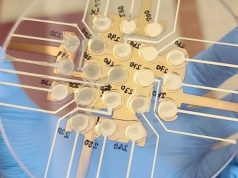Horn, the technology leader in tool production, uses additive manufacturing for tool production as well as conventional manufacturing methods. With a Solukon SFM-AT350, the precision tool manufacturer Horn is now optimizing the postprocessing of the parts it produces with selective laser melting.
Founded in 1969 in Tübingen, Germany, the carbide tool manufacturer Horn is the technology leader in producing precision tools for machining tasks with high standards. Alongside 25,000 standard tools, the family-run company has delivered more than 150,000 custom solutions to its customers in recent years. For such a large volume of production orders, both the manufacturing process and the downstream process steps must be scaled to the greatest extent possible. With the Solukon SFM-AT350, Horn has automated the depowdering of laser-melted metal parts and, in turn, has significantly increased the efficiency of component cleaning.
Solukon SFM-AT350: Reliable cleaning for medium-sized parts
Based on the SPR Smart Powder Recuperation technology from Solukon, the SFM-AT350 cleans complex metal parts weighing up to 60 kg with 2-axis rotation and adjustable vibration in a protected atmosphere. The rotary table of the SFM‑AT350 is infinitely rotatable, while the horizontal axis swivels by up to 250 degrees. This fully automated process removes residual powder from the complex channels inside the parts.
Depowdering tool parts at Horn
The SFM-AT350 is in use several times a week at Horn. Currently, parts made from tool steel and stainless steel and those made from the reactive materials aluminum and titanium are depowdered in the Solukon system. Before cleaning the reactive materials, the SFM-AT350 is inerted with protective gas. Depending on the part size, up to several dozen parts are arranged on a build plate, which are then simultaneously freed from powder in a cleaning process in the SFM-AT350. This makes the cleaning process considerably more efficient and faster. According to Dr. Konrad Bartkowiak, production manager for additive manufacturing, when it comes to depowdering, parts with interior cooling channels, lattice structures or powder residue in the support structures are the greatest challenge.
With the SFM-AT350, the company from Tübingen cleans these complex parts automatically and has complete transparency in terms of the cleaning process. This is made possible by the Digital-Factory-Tool, a sensor and interface set used to monitor all the key data of the depowdering process (e.g., humidity, chamber pressure, temperature).
Main benefits: increased occupational safety and powder recuperation
Alongside the increase in efficiency, Horn decided in favor of a Solukon system for reasons of occupational safety. “The Solukon system increases safety (explosion protection) because we can also use it to depowder metal parts made of reactive materials in a protective gas atmosphere,” said Bartkowiak. Bartkowiak and his team also rely on the Solukon system for its contribution to sustainability. “We can sieve the discharged powder and then reuse it. Depending on the part size and cavities, this can add up to a significant amount of powder,” said Michael Schäfer, a designer and system operator in Additive Manufacturing at Horn.
Subscribe to our Newsletter
3DPresso is a weekly newsletter that links to the most exciting global stories from the 3D printing and additive manufacturing industry.






















